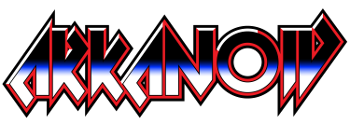Work And Art
Art, in its many forms, exists in every community, every culture, and every country. Art has been created since time began, evidenced in cave paintings and rock art. Some times creativity can be a struggle, some times if overwhelms you. When it is working, you completely go into another place, youre tapping into things that are totally universal, completely beyond your ego and your own self.
My work and my art
My background is varied, from Commodore C64 and Amiga coding, electronics, planning, IT management, economy, facilities management, software development, animation and design. Very wide experiencepool I agree, but life has offered me many opportunities workwise, so this is what I have worked with. Lately life (or age?) has guided me into an advisory position for high school students , so for the moment this is what I work with.
During the path of work I always somehow found a way to be creative. This pages is for showing off the works of art which have emerged from all the positions I have had. The years from 1998 till 2008 was a great time for the now more or less obsolete technologies Shockwave and Flash.
Flash Developer and Designer
Coming from the scene as a young kid as a coder and a designer, i embraced Macromedia Shockwave and Macromedia Flash.
Later both techologies were bought by Adobe, and have the later years dimmed more and more in use. Using these technologies was
however was never the less quite familiar. I did during the time Flash was popular get a
Certification as a Flash MX Designer and Flash MX 2004 Developer.This was taken in
the time period which I worked with DataPower, Scheidegger Training and ViewStart.


I enjoyed immensely working with Flash which for me was a natural path from developing games and programs in Shockwave. It is actually with a bit of nostalgia I present some of the small work and animations I did make 15 years ago.
I you like an Arcanoid type of board game, I have added a tiny rather incomplete version here, which I have made with Flash MX2004. It contains the sounds and feel from the original game from the Amiga released in 1987.
Flash and Shockwave offered an at the time unique combination of programming and design. In a way I feel that is still valid today. The choice are not many if you want to create an online game or an online programmed animation. HTML5 was at one time offered as a solution, and I presume <canvas> and JavaScript can do the same as Flash can do. Nevertheless, my believes are that the "not so very light" Flash player plugin just by its size larger than 30 megabytes caused the technology to be more and more obsolete. And after the introduction of mobile platforms not even supporting the Flash player it was more or less stopped beeing used.
Working with Flash for quite a few years did fill a few websites. Some of that work I present on this page. Most of the animations were designed and produced for companies I worked in.

This bike is a Flash Image I made as a part of a Internet Template for the company I used to work for: ViewStart AS


The same applies to this New Beetle. This image also is made is Flash and can be scaled without loss in quality.


These two images was a part of a package of graphics used in ViewStart Vision. Their Flash Web design software.
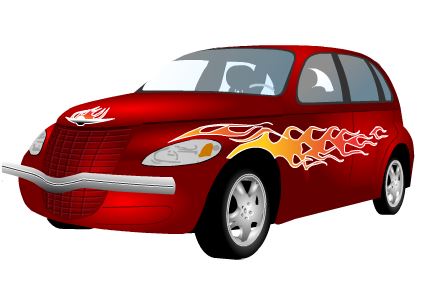
Here I list a few templates I made having a face in the upper corner plus some various ones. These are examples of the internet templates I have made. I show them off here as examples of my work.


There are several smaller projects I have made in Flash, click this link for an example of a Flash Animation web page for ViewStart AS
Director / Shockwave Developer
I have been working with Shockwave and Flash since 1998, and have over the time achieved great knowledge in using them. The years from 1997 and 2003 I have mainly been working with interactive training. tutoring how to use computer programs. This work has been done for several companies over the last 7 years. Here is an example of one of these. This animation is made in shockwave, where I generated a simulation engine, on which I can add a shell around, which interacts with the user. This means is a quick task to alter the interactivity for a new exercise, and keep the same simulation engine inside. The same animation can also by this shell encapsulating, easily be played back as a showme video instead, where there is no interactivity.
Here is a shockable 3D engine I developed for Director , just before Macromedia released Director 8.5 with a BIG and LOVELY 3D engine... Hehe... but still.. my routine is pretty swift and quick. Originally it was made for a demo on Amiga 500 back in 1990. (I was Experiment IV member of Arcadia Team, and we coded several demos in assembler.) The MegaDemo from 1989 among other TAT productions if available on youtube for your enjoyment.
Green Balls of Fire, particle animation. Use the mouse pointer to move the 3D particle animator.
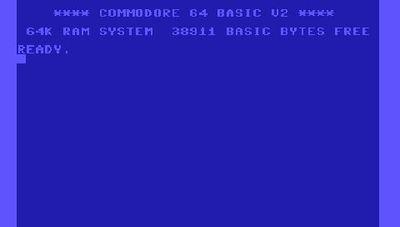
If you are interested in Commodore and Amiga computers, test the "Back to the good ol' days" animation I made in
sheer hype over finding the Galvay is God First Blood music! Excellent
time back then! I still have my good old Commodore 64, with a
diskdrive.. and some demos Along with 3 amigas and a Spectrum...
Programming C64 and Amiga
Design and development, it have been my passion since the time I was programming the Commodore 64 and the Amiga. Back in the old days when life happened on the Scene, demo and intro programming were the main time occupation. I dont have a clear thought if these years in the mid 80's did influence my work choices, or if my creativity did push me into programming. We were a small crew in The Arcadia Team but we made impact, and were one of the early crews which really did explore how the C64 and the Amiga hardware could be utilized. Back in those days, it was all the young kids which were not influenced by rules and limitations who did explore the possibilities in the hardware which was available.
The Commodore 64 is a very good example of this. The hardware did originally come with a Multicolor Mode and HiRes mode from Commodore (Well it was a total of 5 modes, which was variations of the two), but there are ways of enhancing the grapics yet known to the manufacturer Commodore themselves.
MultiColor Mode
MultiColor mode generates the screen with resolution 160*200 pixels/16 colors. One pixel
represents an area 2*1 pixels big. The screen is divided into 40*25 attribute cells.
Each attribute cell is 4*8 pixel big. In this mode you can use maximum 4 colors in the
attribute cell. Each pixel defined by 2 bits can have one of 4 different colors.
One of colors is the background color.
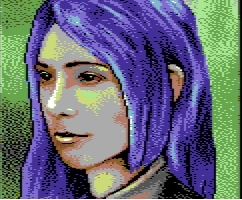
Multicolor Picture by Grumbel
Hires Mode
The colors available to HiRes was 16 colors. Not exactly anything to create art with. The picture below is a good example of this.
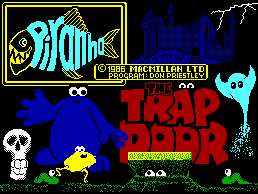
This mode was not very popular even if it was possible to design very detailed and nice pictures with it.
MultiColor Mode Interlaced
The MCI, Multi Color Interlace mode
a 320 by 200 pixel resolution. Each 8x8 pixel cell can have 4 colors. In this way it was possible to mix two colors
together, so there are 4 theoretical amount of 128 colors. This was realized by using two MCI pictures (160x200/4 colors in 4x8 cell) each using
its own attributes.
MultiColor Interlaced
Multi Color Interlace has a 320*200 pixel resolution. It is possible to use 4 colors in each 8*8
points attribute cell. This mode gives the possibility of mixing two colors together,
so there are 4 of theoretical amount of 128 colors. This mode uses two MultiColor pictures at 160*200/4
colors in 4*8 cell each, using its own attributes, except the color RAM at $d80 which must be shared by both pictures.
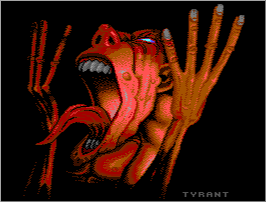
MCI Picture by Tyrant/Therapy
These two MCI pictures alternates each frame, but one of them is shifted one point to the side. This causes visible effect of jerky movement from side to side, but it improves the fineness of the C64 MCI mode and gives the artist a larger color palette.
FLI Mode
Flexible Line Interpretation mode generates same resolution as standard MultiColor mode - 160*200 pixels/16 colors.
This technique allows to use more colors in the attribute cell. It allows artist to use the full palette of 16 colors
in each 4*8 pixel big attribute cell.
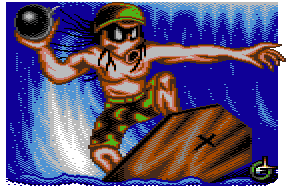
FLI picture by Electric/Extend (Morbid Art I)
It's realized by a special routine, which by changing values in the VIC register $D011 causes that Bad Scan Line (which later in this text is called Caroline) is on each rasterline of visible screen. For those who don't know what a "Caroline" is: Caroline occur each 8th rasterline. It's the time when the graphical processor of C64 (VIC) is loading graphic data from memory.
IFLI Mode
Interlaced Flexible Line Interpretation is the connection of two greatest ideas in history of C64 graphic modes.
MultiColor Interlaced mode (MCI), and Flexible Line Interpretation mode (FLI)
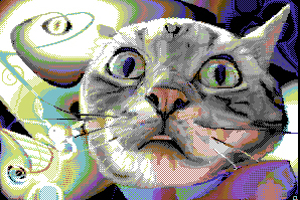
IFLI Picture by Deekay
Interlaced FLI generates 320*200 dots resolution using 6 colors in each 8x1 points big attribute cell. This mode also gives the possibility of mixing two colors together, sit it is possible to use theoretically 128 different colors.
Super Hires FLI
Super Hires Interlace FLI
Super Hires FLI can generate pictures in resolution of 96*167 pixels/16 colors.
Instead of HiRes picture, it uses the HiresFLI picture as a background layer.
It can use 4 different colors in the 1*8 pixels big attribute area.
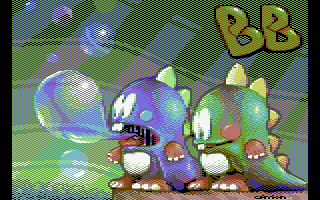
IFLI Picture by Valsary/Samar/Lepsi
2 colors are same for the whole picture, the background, and foreground color can be set separately for each attribute area. Super Hires Interlace Fli alternates two SHF pictures each frame.
Quite a lot of graphic modes possible in a hardware designed from the manufacturer to have quite a lot less!
NOTE:
Roland Toegel - Crossbow/Crest - is the inventor of SHF and SHIF modes.
For these, few, who doesn't know, let's say that he is famous coder and excellent graphician.
He is in the scene since eighties, and since the beginning he together with Goldrush, produced
demos based upon excellent ideas.

I have always liked drawing with charcoal or soft tip pencils. I like drawing portraits, nature or act studies, since the soft tip pencils is an excellent tool for drawing shades. This pencil drawing are named the "Tree of loneliness", it was created in 1982, when I was 17 years old.
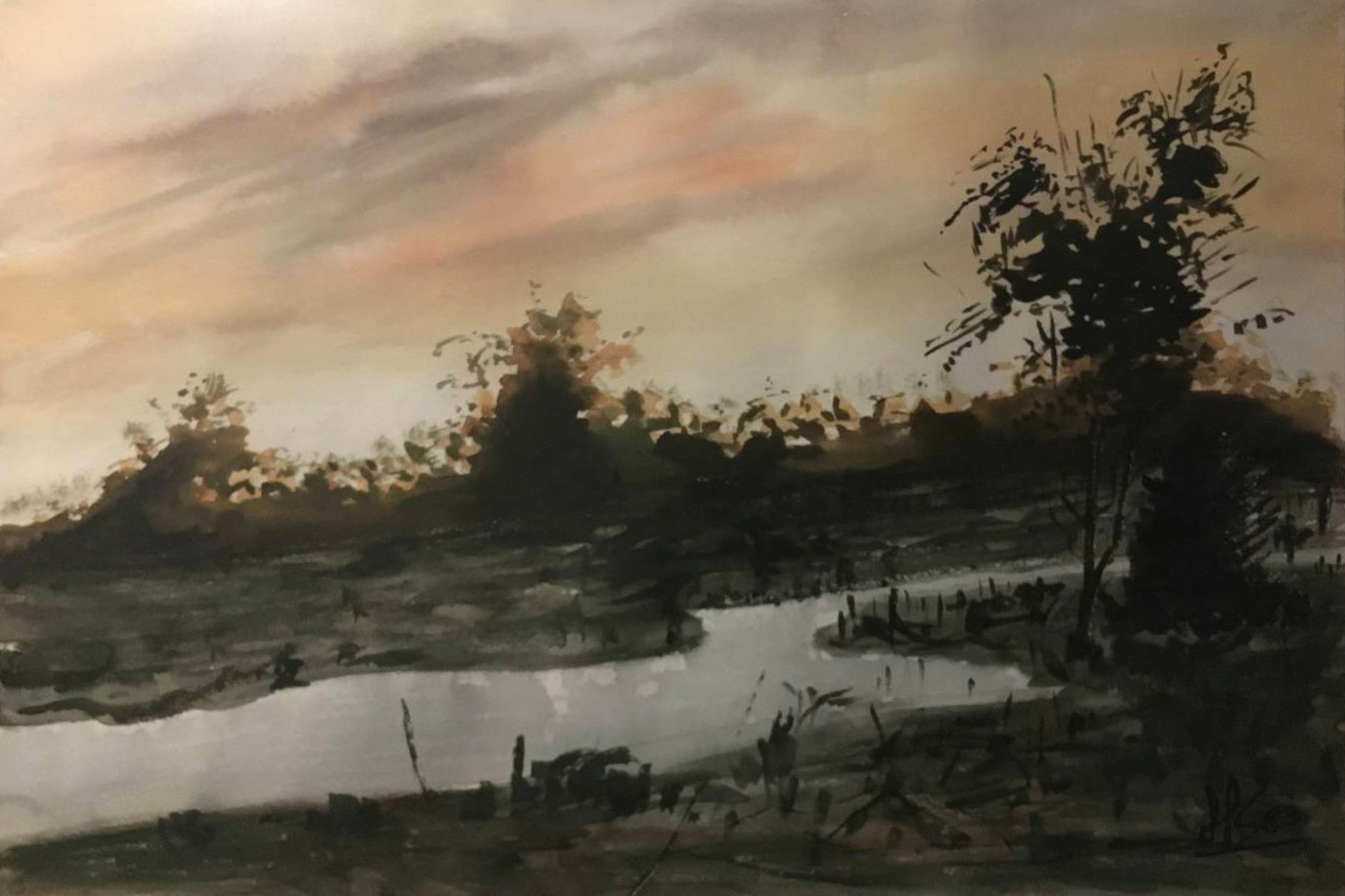
I have also a few aquarell paintings which I have enjoyed a lot painting. My choice of
watercolor paper is the type which are made entirely or partially with cotton. That gives
a good texture and minimizes distortion when wet.
I have only done one oilpainting, but it was not for me. Aquarell painting did for me flow
naturally, the oil paint needed to be pushed around the canvas.
Did quite a few works using ordinary colored boardchalc, liked it a lot, but the works were
short lived it not fixed quickly!.
Visual Basic / C# / ASP.NET / Cold Fusion / Java Script / Java
I have been working with visual Basic, and as a 50% owner of the company InfoTech ANS, we have developed and sold 3 programs to norwegian medical personell. The last software Lungen which was installed on all medical offices in norway. Lungen is used to follow up, treat and register astmatic patients sickness and sickness development.
One of my works in the UK were developing the Interactive Training content and the www.scheidegger-online.com Webplatform for Sheidegger Training in Luton England. The platform was based on Microsoft IIS with Microsoft SQL 2000, where the interactive learning platform itself were designed using ColdFusion. The content were designed using HTML and Shockwave elements. In addition to this web platform, I also developed a CDROM version, where the username/password and non copyable issues were solved using Visual Basic and DHTML.
I have developed and built several websystems, one I wish to mention in particular was the customer support and registry database for the telecompany Tele1 where I was employed. This system did consist of a storage module, customer database and systems for calculating mobile phone usage with reports. The system was made in Visual Studio in C Sharp ASP.NET.
Of the GPS systems worth mentioning must be the GPS based Obstacle Warning system to help pilots to avoid flying themselves in to powerlines and obstacles which can interrupt flying and lead to accidents. Read more about it on Nobilesofts pages.
Music.
Check below to listen to three pieces I have made for various projects in the last years.
Dance mix:
Background musak theme:
Intro musak theme:
I probably make more soundscapes than music I guess, but it is made using my Yamaha PSR 8000, PRS-S750, P80 and my computer with various softwares.
All items in this page are copyrighted by the author Harald Sakshaug if not otherwise stated, and cannot be used without a written acceptance.
Copying , compiling or reuse without the authors acceptance is illegal.
